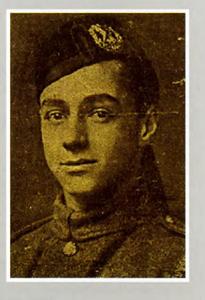Roll of Honour World War I 1914-1918
Name: Harley, Allan Langlands
Rank: Private

Service No. S/42003
Regiment: Seaforth Highlanders 4th Bn.
Died 09/05/1918 Age 18
Buried or commemorated at CABARET-ROUGE BRITISH CEMETERY, SOUCHEZ VIII. H. 22. France
For Commonwealth War Grave Commission click here
In detail:
That we know a little more about Allan Harley, is almost entirely due to an article that appeared in the Perthshire Advertiser in 1918. Educated firstly at Perth Academy, he later attended Strathallan as one of the original boarders in 1913, becoming Captain of School in 1916-17, with a distinguished academic and sporting record. He had passed the Junior Cambridge Examination in 1915, finishing second in the British Empire at his branch of study, then passed the Senior Cambridge in the first rank, at 16, the following year. During his last year the School eleven won every match during the cricket and football seasons. He was a great favourite with the boys in the School, especially the younger ones, and on going up to the ‘Varsity’ he was ‘chaired’ to the station by his admiring School fellows. In 1917 he was due to go up to Edinburgh University to study medicine but was instead called up for war service at age 18. Enrolling as a private in the Argyll and Sutherland Highlanders, after training he was seconded to the Seaforth Highlanders who saw action in the area near Arras and the Somme in the latter years of the war. Barely three days after landing in France Allan was listed as missing in action. His death is registered as 9th May 1918. He was buried in the Cabaret Rouge British Cemetery near Souchez in France. He was only 18.
He was reported missing on the 9th of April.
Efforts were made to find him to no avail and he was presumed dead. The war ended later that year, then, in early 1919, almost a year after Allan was reported missing, his parents received a postcard written by him. It was not, however, the news they had hoped for; on it, in a different hand was the news that Allan was dead. It turned out that he had been wounded by a shell and was left lying for two days.
He was taken prisoner by a German officer, then moved, with a few others, to a field hospital in Seclin, east of Bethune, and cared for by two sisters from a nearby nunnery. There, he wrote the postcard to his parents but the Germans did not allow him to send it.
Although his injury was not initially life-threatening, he developed a fever after he was operated on and died at midnight on May 8th, 1918, a month after he received his injury. He was buried nearby. He was just 18 years old. That perhaps would have been it and his parents may never have found out. The Germans evacuated the area and burnt anything they thought might be useful to the Allies, but Allan's postcard was found and one of the sisters posted the card to his parents, adding details of his death and capture. His brother, Private George Langley visited the hospital and the grave in the cemetery in Seclin and personally thanked the sister who nursed him before and after his operation. Allan's body was moved to Caberet Rouge cemetery near Souchez. He is, of course, named in the Roll of Honour at Strathallan School, along with James Gowans and George Mollison, the first three Captains of Strathallan School.
4th Battalion of the Seaforth Highlanders.
Allan was born in Perth and, like Jame s Gowans,went to school at Perth Academy (where he is also listed on the memorial board) and probably came to Strathallan in 1916. Shortly afterwards, he became Strathallan’s third Captain of School. Aside from sport, Allan was also an exceptional scholar. He passed the Junior Cambridge Examination in 1915, finishing second out of 2000 entrants, then passed the Senior Cambridge in the first rank the following year. His popularity was such that, on leaving Strathallan for a medical course at Edinburgh University, he was escorted shoulder-high to the station at Forgandenny (yes,there used to be a station there) by the whole school. Soon afterwards, while at University, he found the call to arms too strong and joined the Argyll and Sutherlands as a volunteer before transferring to the 4th Battalion of the Seaforth Highlanders.


